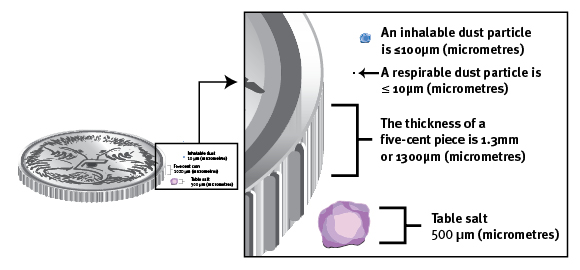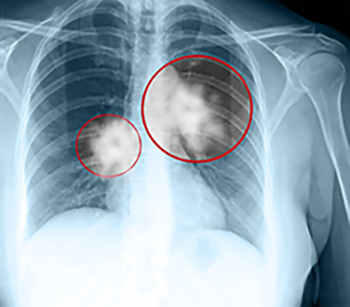Hazardous dusts
All airborne dust is hazardous to health.
Dust can contain a range of materials including sand, dirt, pollen, minerals, wood, micro-organisms, and vehicle and industrial exhausts.
Where dust exposure is likely to occur
Dust can be a problem in almost any industry. Many work activities can create or release dust.
Examples include:
- filling bags or emptying them into skips or other containers
- weighing loose powders
- cutting materials (e.g. example paving stones)
- sieving and screening operations
- conveying materials by mechanical means or by hand
- stockpiling large volumes of processed materials
- crushing and grading
- milling, grinding, sanding down or other similar operations
- cleaning and maintenance work
- handling livestock feed and bedding
- working with livestock and animal waste
- clearing up spillages.
The importance of particle size
Dust (created or released by work processes or activities) is made up of particles that range in size from relatively large to very small. Large particles fall to the ground quickly and are generally too large to be breathed in.
Smaller dust particles can stay airborne for a significant amount of time and can be classified into two groups:
- Inhalable dust (smaller than 100 micrometres (µm)) - visible dust which can affect your upper respiratory system (the nose, mouth, throat or upper respiratory tract).
- Respirable dust (smaller than 10 µm) - these dust particles are so small that they are invisible under normal lighting conditions. Their extremely small size also means they can be breathed deep into your lungs and lead to lung damage.
Image 1: Particle sizes compared to a five-cent piece

Image 2: Respirable dust can only be seen under special light conditions such as when looking into a sunbeam while standing in a darkened room.

Health effects
Exposure to any dust in excessive amounts can lead to health problems. The size of the dust particles, what they are made of, and how much is in the air all affects how hazardous the dust can be.
The harmful effects of dust can vary, from skin irritation to lung cancer.
Dust may not be an obvious hazard because the particles are often invisible and the health effects of exposure can take years to develop.
Inhalation
The build-up of dust in the lungs can cause lung inflammation and eventually scar tissue (fibrosis). This could lead to breathing impairment. These conditions usually develop slowly and symptoms may not appear until severe, irreversible changes have taken place.
Some dusts are well known for their ability to produce serious lung diseases, for example respirable crystalline silica (RCS) can cause silicosis and lung cancer. Long term health effects caused by dust in the lungs are usually permanent and may be disabling. Prevention of the onset of disease should be the highest priority.
Certain dusts (e.g. from grain, flour, wood, reactive dyes and proteolytic enzymes) are respiratory irritants and sensitisers. These can cause occupational asthma (attacks of coughing; wheezing and chest tightness), rhinitis (runny or stuffy nose) and extrinsic allergic alveolitis (symptoms can include fever, cough, worsening breathlessness and weight loss).
How can breathing in dust affect you?
PneumoconiosisA group of restrictive lung diseases like silicosis, talcosis and asbestosis, where dust exposure causes debilitating lung scarring. |  |
Chronic Obstructive Pulmonary Disease (COPD)COPD (also called Chronic Obstructive Airways Disease) is an umbrella term for long-term disease of the lungs including emphysema, chronic bronchitis and chronic asthma. | |
AsthmaAn obstructive lung disease, linked to exposure to irritants or allergens (sensitisers) at work. A reversible shortness of breath. | |
Extrinsic allergic alveolite (EAA)An allergic condition which affects workers exposed to biological dusts, causing conditions including farmers' lung and bird fanciers' lung. | |
Fibrosing alveolitisAlso known as pulmonary fibrosis, can be caused by some occupational dust exposures, for example work with cobalt or 'hard metals' in cutting tools. Related conditions, 'flock workers lung' and 'popcorn lung' are other occupational diseases that results in obstruction of the smallest airways of the lungs (bronchioles) due to inflammation. | |
CancersThe growth of abnormal cells, particularly of the lung and nose, are related to substances commonly encountered at work, including asbestos, silica, chrome VI, nickel, cadmium and wood dust. These account for thousands of work-related deaths each year. | |
Heart diseaseDust-affected lungs put extra strain on the heart which can lead to right-sided heart failure. Some occupational exposures, such as hard metal dusts, can cause potential fatal conditions like cardiomyopathy. Very fine dust particles cause inflammation of the heart and a higher risk of heart attacks. | |
Other problemsExposure levels that are half the allowable level for most workplace dusts can overwhelm the body's first line of defence, the mucociliary clearance that filters out dust in the upper respiratory tract. This can leave the worker more vulnerable to infections and more susceptible to occupational lung disease. Lots of other dust related conditions occur, some specific to particular exposures: beryllium is linked to sarcoidosis and chrome dust to chrome ulcers. | |
Skin contact
Some dusts such as epoxy resins, rubber processing chemicals, wood dust and fibreglass can cause skin ulceration, irritation and/or sensitisation (dermatitis).
Eye contact
Dust particles can cause eye damage or irritation, due to the chemical and/or physical properties of the material.
Ingestion
Some inhaled dusts can become trapped in the mucus that lines the respiratory tract. This mucus tends to be either spat out or swallowed. Inhaled dusts can get into the digestive tract, where they can cause local effects such as gastrointestinal tract irritation. Alternatively, it can affect other organs and tissues via the bloodstream (e.g. lead).
Dust particles may also enter the digestive tract through eating, drinking and smoking with contaminated (dirty) hands. It is important for workers to maintain good personal hygiene standards and to regularly wash their hands.
Controls for certain types of dust and dust-generating activities
- Abrasive blasting Code of Practice 2021 (PDF, 1.13 MB)
- Asbestos
- Construction dust: respirable crystalline silica
- Demolition work Code of Practice 2021 (PDF, 0.66 MB)
- Foundry (PDF, 0.71 MB)
- Lead
- Q fever
- Respirable crystalline silica